
FitzGerald campaign thrashed by Kasich on fund-raising front
Some Democrats still see chance for November victory
6/1/2014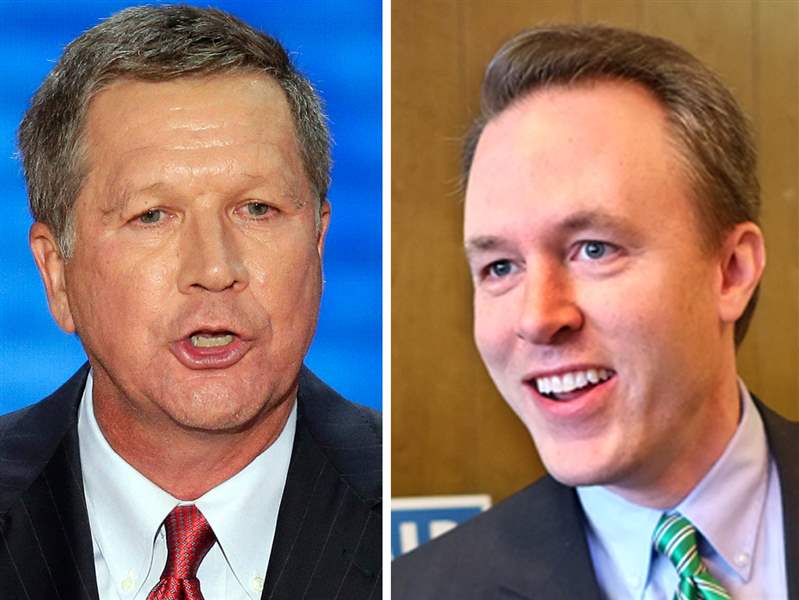
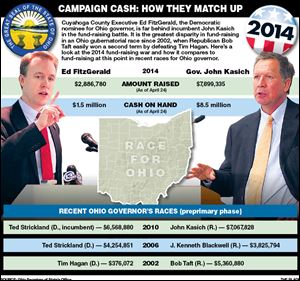
Democratic gubernatorial candidate Ed FitzGerald may be a great Cuyahoga County executive, former FBI agent, and family man, but as a fund-raiser, he’s got a lot of learning to do.
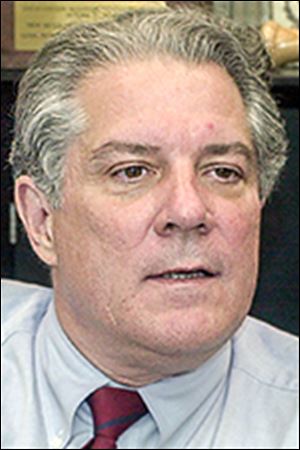
Hagan
That’s the opinion of some Democratic insiders who are watching with concern as Mr. FitzGerald’s campaign lags behind his Republican opponent, John Kasich, in raising money.
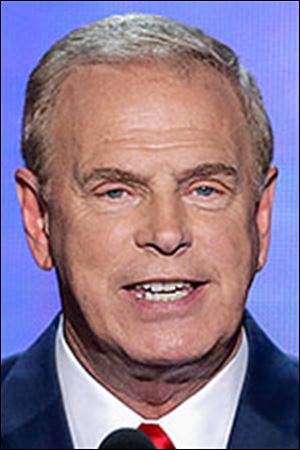
Ted Strickland
One national Democratic Party fund-raising official only willing to speak on background said the FitzGerald campaign was off to a rocky start and hasn’t really recovered.
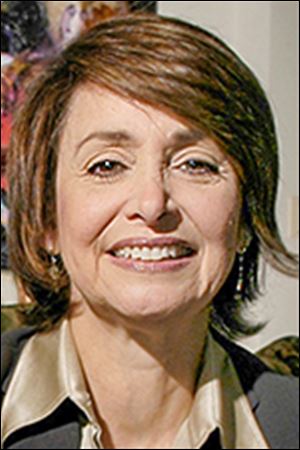
Moresky
Others say that, as problem-plagued as the FitzGerald roll-out has been, Mr. Kasich has enough vulnerabilities and Mr. FitzGerald has an appealing enough story to tell that it‘s too early to write him off.
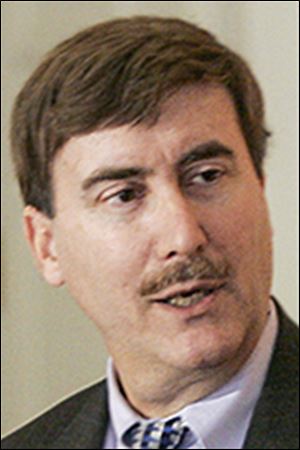
Sabato
According to the most recent campaign finance reports, Mr. FitzGerald has raised $2,886,780, compared with $7,899,335 by Mr. Kasich. Heading into the post-primary campaign, Mr. FitzGerald had a campaign war chest of $1.5 million, while Mr. Kasich had banked $8.5 million.
A Blade review of Mr. FitzGerald’s fund-raising effort during 2013 and in the preprimary report of 2014 shows him well behind where Democrat Ted Strickland was at the same time in both his first campaign for governor and his 2010 re-election effort.
Four years ago, in the race against Mr. Kasich, Mr. Strickland raised $6,568,880 by this time — three times as much as Mr. FitzGerald in the current period and nearly as much as his opponent. Mr. Kasich, a former congressman, Fox News host, and investment banker, had raised $7,067,828 for his 2010 run against Mr. Strickland.
In 2005 and 2006, Mr. Strickland, a former congressman from southeast Ohio, raised $4,254,851 through the preprimary phase for his run against the Republican nominee, Ohio Secretary of State J. Kenneth Blackwell. Mr. Blackwell raised $3,825,794 during 2005 and through the preprimary phase of 2006.
For a worse mismatch, you’d have to go back to 2002, when Democratic former Cuyahoga County Commissioner Tim Hagan ran against incumbent Republican Gov. Bob Taft. Mr. Hagan lost after a campaign in which he was outraised $10.7 million to $1.4 million. In the preprimary phase, Mr. Hagan was outraised $376,072 to $5,360,880.
Said one national Democratic Party fund-raising professional, “I think the campaign’s rough start, which lasted for quite a long time, up until they had to drop their lieutenant governor off the ticket, has made a lot people think that they don’t know what they’re doing.”
The fund-raiser said big-ticket donors may have written off Mr. FitzGerald’s struggle to concentrate on races that are perceived as winnable.
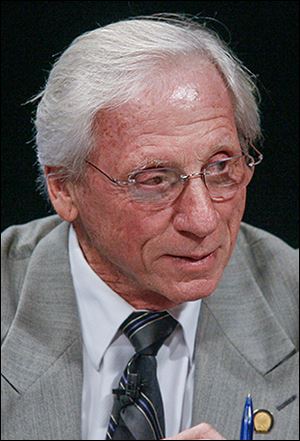
Jerry Chabler.
Asking for cash
Locally, Democratic fund-raiser Jerry Chabler said he had three meetings set up in Toledo between Mr. FitzGerald and potential contributors and the FitzGerald campaign canceled all three meetings because of scheduling conflicts. Since that “unfortunate” set of events, two of the meetings have been rescheduled and the third meeting is expected to take place as well.
“The best fund-raiser in a campaign is the candidate,” Mr. Chabler said. “Ed FitzGerald needs to set aside four to five days a week, three to four hours a day, on the telephone soliciting contributions, especially against an opponent who has $9 million,” acknowledging Mr. FitzGerald has to balance his time with his full-time duties as county executive.
Mr. Chabler said Mr. FitzGerald needs to bring in some “heavy hitters” — people like former President Bill Clinton — to flush out big donors. He said Mr. FitzGerald still has “an outstanding chance” to get elected and no one should rule him out.
Upper Arlington real estate businessman Annette Trembly, 72, gave $10,000 in April, 2010, to Mr. Strickland and said she’s “appalled” at the Republican Party, especially its stance on women’s issues. However, she hasn’t sent Mr. FitzGerald a dime. Aside from receiving the routine tide of emails and letters imploring money, she hasn’t received any targeted outreach from Mr. FitzGerald, as far as she knows.
“I get stuff in the mail, a lot of calls for small contributions. He hasn’t reached out to me for a large contribution,” Ms. Trembley said.
Karen Cassady of Cincinnati, who gave $5,000 to Mr. Strickland in April, 2010, isn’t sure she’s going to support Mr. FitzGerald this year. She says her husband’s business is doing well and she feels Mr. Kasich deserves some of the credit.
“The economy picked up again so they’re giving whoever’s in office the credit. I have considered it [giving to Mr. Kasich],” said Ms. Cassady, 59, who calls herself a “retired homemaker.”
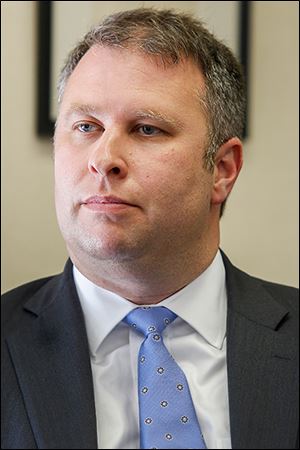
State Republican Chairman Matt Borges.
A tough year
David Cohen, political science professor with the Bliss Institute of Applied Politics at the University of Akron, said it’s a tough year for Mr. FitzGerald, and he’s not helping himself with a campaign that seems not optimally organized.
“FitzGerald’s going to have a tough time raising money because the perception out there is he’s going to lose,” Mr. Cohen said. “I’m not saying he’s a bad candidate, but the hurdles he has to overcome, such as name recognition, you need a lot of money to overcome.
“The Democratic operatives that I’ve spoken with, they’re already looking to 2016. There’s a great hope among Democrats that they can save the [U.S.] Senate [from a Republican takeover] by the narrowest of margins and the feeling is if that’s possible that’s where the money should go.”
Lauren Hitt, press secretary for Mr. FitzGerald, disputed the view that Mr. FitzGerald’s fund-raising effort is deficient.
“The campaign has an active event schedule which is why we were able to match the governor’s campaign nearly dollar for dollar between January and April of this year, raising $1.42 million to their $1.5 million,” Ms. Hitt said.
She said it is not realistic to expect a challenger to have raised the same amount of money as an incumbent — either Mr. Kasich this year or Mr. Strickland four years ago.
“There’s no doubt that Ed is different from any candidate who has run for governor in the last couple of cycles. He never worked on Wall Street, he never ran for Congress, he doesn’t have a stock portfolio,” Ms. Hitt said. “He is nontraditional so his fund-raising is going to be a little nontraditional.”
Mr. FitzGerald is a former FBI agent, former mayor of Lakewood, and is married with four children. According to Ms. Hitt, his wife, Shannon, works two jobs.
“He certainly does not have the connections that John Kasich has, but that is also what makes him an appealing candidate, as someone who is going to be able to work for the middle class and make Ohio work for everybody, not just the wealthy and well-connected,” Ms. Hitt said.
‘A brutal pace’
Since the start of Mr. FitzGerald’s campaign there have been whispers that he was not raising money at the rate that he should be, or he wasn’t putting in the phone time required.
“Ed is someone who has come up through local government, who lives modestly and takes pride in that, and is in a very refreshing way not somebody who is going to call someone he doesn’t know out of the blue and solicit them for tens of thousands of dollars,” Ms. Hitt said.
“It would be wrong to suggest the fund-raising is somehow the result of Ed not going out there and working hard enough. The campaign takes a brutal pace and he puts a lot of emphasis on getting out there and really meeting and talking with Ohioans,” Ms. Hitt said. “He takes a lot of pride in having a campaign that’s for Ohioans and funded by Ohioans.”
Democrats are hoping that the furor over Senate Bill 5 in 2011 is still potent enough to drive union-connected Ohioans to the polls to oust Mr. Kasich. The governor was a supporter of the Republican-backed bill that would have undermined the bargaining power of public employee unions. It was defeated in a statewide referendum in which union leaders and Democrats forged an even stronger bond than already existed.
Or so it seemed.
Union issues
Affiliated Construction Trades Ohio, a foundation representing unions made up of carpenters, electricians, sheet-metal workers, and others who depend on government-funded capital projects, donated $12,155 to Mr. Kasich’s re-election campaign. That came after the governor got behind a plan to borrow against Ohio Turnpike tolls to generate a $3 billion building program.
Four years earlier, the same organization gave its money, $11,395, to Mr. Strickland, the Democratic incumbent — perhaps proving only that the incumbent has an advantage.
Democrats say it’s not just the past fight of S.B. 5 that should worry unionists, but the potential for a Republican-sponsored right-to-work law after the 2014 gubernatorial election.
“If John Kasich is elected you will see right-to-work enacted,” said Mr. Chabler of Sylvania. “No question about it.”
Yes, question about it, according to Dennis Duffey, head of the Ohio Building Trades Council and the mastermind of the $12,155 contribution to Mr. Kasich. He doesn’t believe Mr. Kasich will pursue a right-to-work law.
“[Mr. Kasich] has said twice in meetings with members of my board that he doesn’t believe that Ohio is in need of right-to-work and he doesn’t believe it’s necessary,” said Mr. Duffey of Monclova Township. “I’m going to take him at his word.”
Since making that contribution — and bringing down the wrath of other unions in Ohio, Mr. Duffey’s organization has put off making an endorsement in the election.
“We’ve got a board meeting in July. There’s sentiment on both sides here,” Mr. Duffey said.
Lack of vision?
State Republican Chairman Matt Borges said Mr. FitzGerald’s campaign is not raising money because it is “flaccid” and “inexcusably inept” and has no coherent message. He also said the Kasich campaign will make sure voters are acquainted with what the Republican Party sees as Mr. FitzGerald’s lack of vision and lack of understanding of how state government works.
“We’ll have the wherewithal to do that,” Mr. Borges said. “It remains to be seen whether or not they’ll be able to push whatever message it is that they’re trying to formulate.
“We’re going to continue pressing forward with our message, which is obviously working and reflects that people want to invest in four more years of growing Ohio‘s economy,” Mr. Borges said.
Numbers game
A recent poll by the independent Quinnipiac University (Conn.) Polling Institute has increased Democratic gloom that Mr. FitzGerald’s campaign is falling irretrievably behind. According to the poll of 1,174 voters, Ohio voters would vote for Mr. Kasich by 50 percent to 35 percent.
The University of Virginia’s Center for Politics’ Crystal Ball lists Ohio as “likely R” on its 2014 gubernatorial election map.
“I have yet to find anybody predicting that Kasich isn’t going to win who is not a die-hard partisan Democrat,” said Larry Sabato, center director. “But rarely do we put a state as competitive as Ohio in the ‘safe’ category unless it is so one-sided that you can’t imagine the other candidate winning. ... Four years ago, polls showed Kasich winning by a wide margin, but it ended up a 2-point race.”
Mr. FitzGerald’s fund-raising in Ohio is also overshadowed by the newly nominated Democratic candidate for governor in Pennsylvania, Tom Wolf, who is also running against a Republican incumbent, Gov. Tom Corbett.
In other states
Mr. Wolf, who won a heated primary campaign against U.S. Rep. Allyson Schwartz, spent $4.5 million on TV ads alone in the first quarter of the year. In all, he raised about $4 million on top of the $10 million he donated to his own campaign. Governor Corbett had raised $8 million as of the March 31 reporting period — a figure very similar to Mr. Kasich’s.
The fund-raising gap in Michigan — also featuring a Republican incumbent, Rick Snyder, seeking re-election — is similar to Ohio’s. As of Feb. 1, Mr. Snyder had $4 million in donations, while Democrat Mark Schauer had raised $1.6 million.
Democratic political cash may be more plentiful in Pennsylvania because the state is more predictably blue in presidential elections and because it has a bigger population than Ohio, with 12.7 million to Ohio‘s 11.5 million, as of the 2010 Census. Pennsylvanians make more money — $28,190 per capita in Pennsylvania to $25,857 per capita in Ohio. That translates to about $60 billion of extra income each year in Pennsylvania.
Illinois is seeing a high-spending gubernatorial contest, with the political shoes on the other feet. Incumbent Democratic Gov. Pat Quinn had a war chest of about $9 million as of mid-April, according to media reports. His wealthy opponent, Republican Bruce Rauner, had $20 million in cash, of which at least $6.6 million he himself has contributed.
The Democratic Governors Association’s Illinois fund had raised about $730,000 to help Mr. Quinn. The Democratic Governors Association has contributed $138,855 to the Ohio Democratic Party to help Mr. FitzGerald’s campaign. The Ohio Democratic Party is Mr. FitzGerald’s largest single contributor, with $685,250 donated — almost a quarter of Mr. FitzGerald’s total funds.
Lana Moresky, a veteran Democratic fund-raiser who chaired Hillary Clinton’s presidential fund-raising effort in Ohio in 2008 and was on the national finance committee for President Obama, acknowledged that Mr. FitzGerald got off to a slow start. She said he’s rising to the challenge of raising money.
“Ed, I’ve seen him over and over again in fund-raising situations. He is absolutely phenomenal. A lot of times candidates come late. He’s right there at the beginning, talking to everybody, shaking everybody’s hands. He’ll sit down after a lot of people have left talking to the host showing appreciation for what they’ve done,” Ms. Moresky said.
As far as expecting national donors to pour money into the Kasich campaign, she said they have their own races that interest them and that it’s early yet for national money. She downplayed the need to defeat Mr. Kasich to set the stage for the 2016 presidential campaign in swing-state Ohio but agreed it helps to have the governor of the same party.
“Going against an incumbent is a whole different ballgame, especially since it’s a statewide race,” said Ms. Moresky, who lives in Shaker Heights and is retired from county government.
“It’s like night and day, especially in the Columbus area. People don’t want to say no to a governor,” she said.
Looking forward
Given Mr. Kasich’s strong performance in a Quinnipiac polling match-up against possible Democratic presidential candidate Hillary Clinton in Ohio, one might expect the Democratic National Committee to look for an opportunity to try to flatten Mr. Kasich’s national political trajectory. So far Mr. FitzGerald has received little direct help from the Democratic National Committee. The DNC says its preferred role is to provide indirect support by building up the state Democratic Party.
DNC spokesman Jason Pitt said the DNC will ensure the Ohio Democratic Party is “well-equipped to elect Ed FitzGerald.”
Former Ohio Democratic Chairman Jim Ruvolo of Ottawa Hills, now a political consultant on medical issues, said Mr. FitzGerald has to pick up the pace of fund-raising, but still has a chance of winning.
“John Kasich is not a beloved figure. He’s capable at any point in time of sticking his foot all the way down his throat, and FitzGerald needs to be in a position to take advantage,” Mr. Ruvolo said. But “he’s gotta step it up.”
Blade Columbus Bureau Chief Jim Provance contributed to this report.
Contact Tom Troy: tomtroy@theblade.com or 419--724-6058 or an Twitter @TomFTroy.